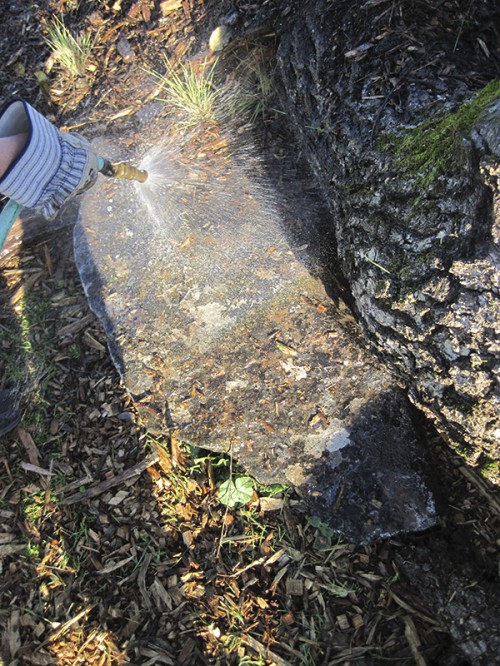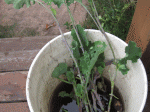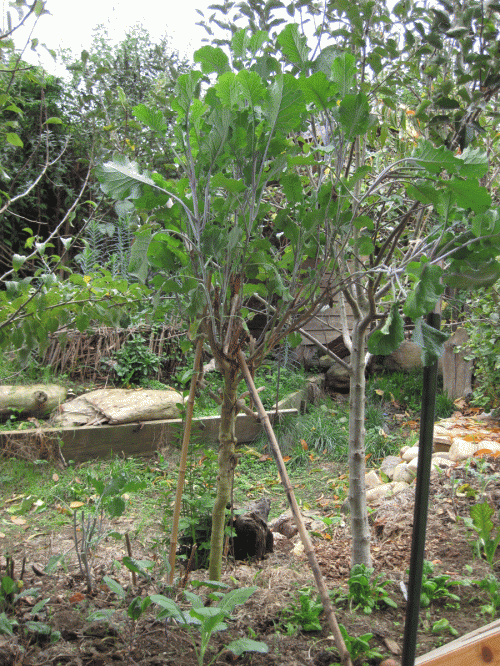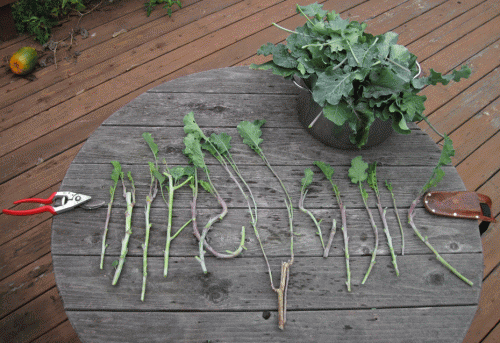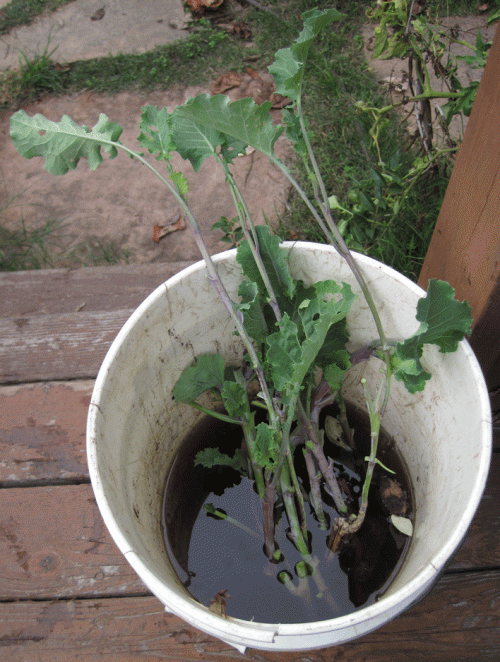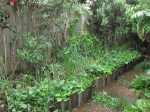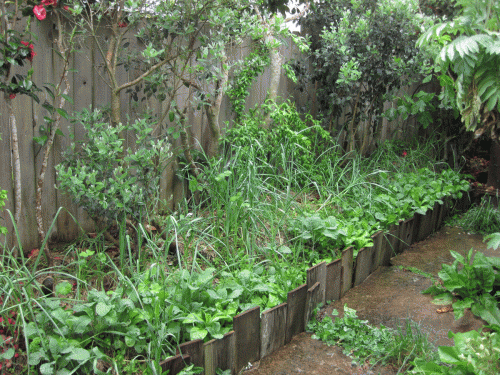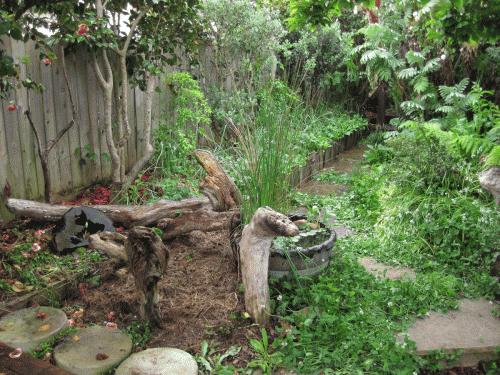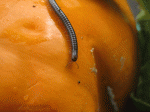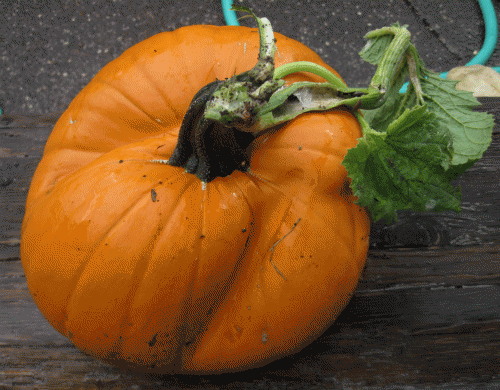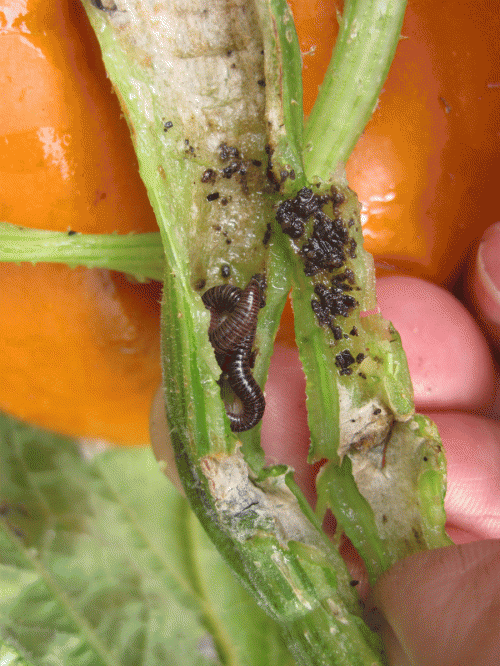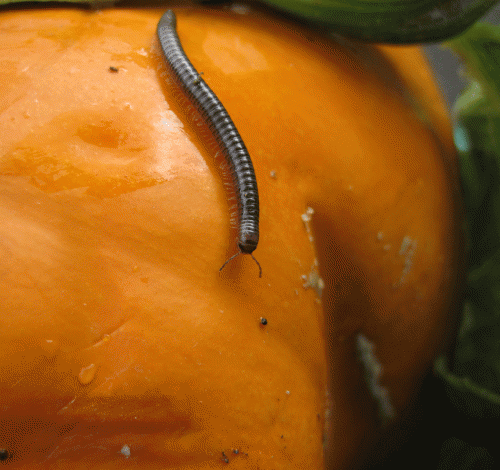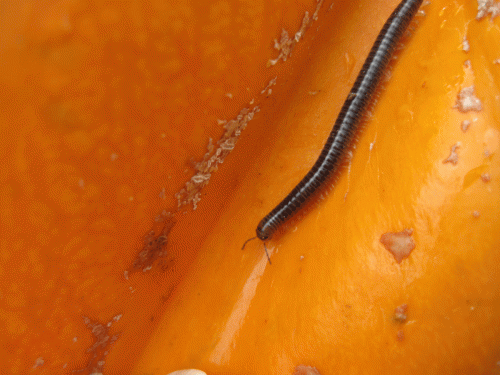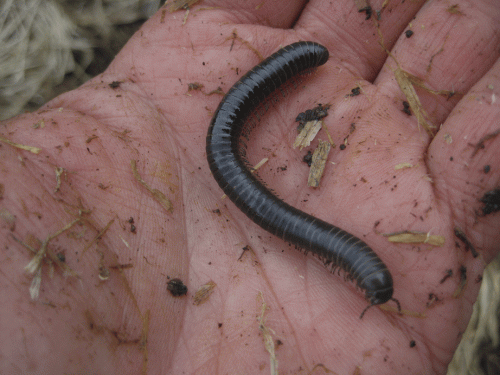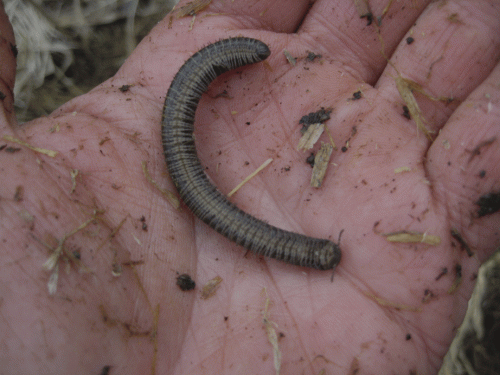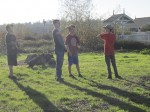
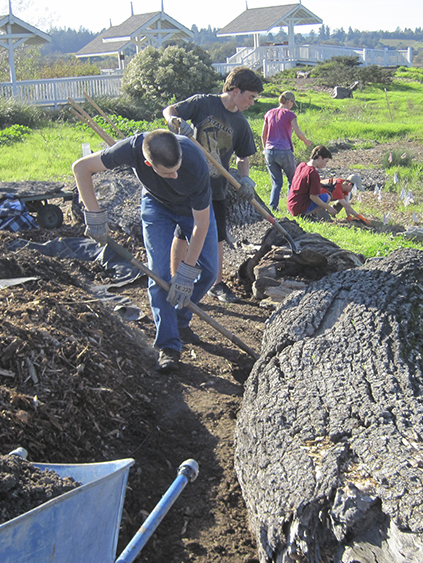 Twisted North Mound is a wildlife habitat installed behind Heron Hall at the Laguna Foundation‘s Laguna Environmental Center, or LEC, located at 900 Sanford Road, Santa Rosa, California, 95401. The installation was an outdoor classroom activity. Date: November 10, 2016. School: Orchard View School, Sebastopol, California. Teacher: Sunny Galbraith. Me: Tony McGuigan, from Spore Lore.
Twisted North Mound is a wildlife habitat installed behind Heron Hall at the Laguna Foundation‘s Laguna Environmental Center, or LEC, located at 900 Sanford Road, Santa Rosa, California, 95401. The installation was an outdoor classroom activity. Date: November 10, 2016. School: Orchard View School, Sebastopol, California. Teacher: Sunny Galbraith. Me: Tony McGuigan, from Spore Lore.
In a nutshell, this wildlife habitat installation is a wad of clay, organic material, topsoil, and new meadow barley plants shoved up against a very large trunk section of a downed oak tree. A large rock slab, hovering off the ground, snugs up to the tree trunk and earthen, cavity-filled mound.
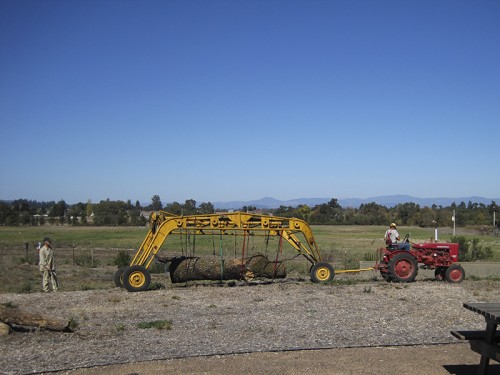 October 2013 (three 3 years ago) Stuart Schroeder, of Stone Horse Farm, uses an “implement carrier” pulled/pushed by a tractor to move West Heron Hall Log into place.
October 2013 (three 3 years ago) Stuart Schroeder, of Stone Horse Farm, uses an “implement carrier” pulled/pushed by a tractor to move West Heron Hall Log into place.
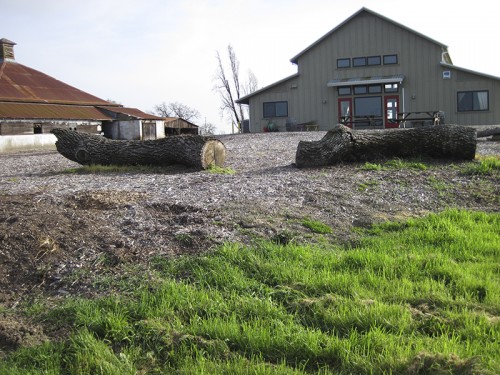 The BEFORE. Heron Hall Logs East (L) and West (R). One goal of Twisted North Mound is to have these large hulks of wood look more naturally placed in the terrain, for instance, as if the tree had fallen on site.
The BEFORE. Heron Hall Logs East (L) and West (R). One goal of Twisted North Mound is to have these large hulks of wood look more naturally placed in the terrain, for instance, as if the tree had fallen on site.
Habitat Installation Day — Prep before students arrive
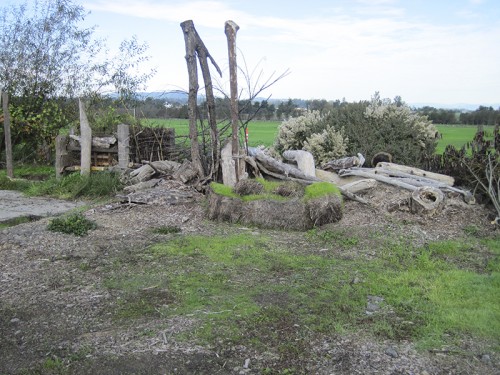 Habitat Resource Depot (fancy name!) at the Laguna Foundation’s compost (left) and woodchip pile (right). Pulled from the depot for this installation: tree logs and small rootballs, rock slab (center), old surface compost with fresh grass weeds, and under-the-pile compost soil.
Habitat Resource Depot (fancy name!) at the Laguna Foundation’s compost (left) and woodchip pile (right). Pulled from the depot for this installation: tree logs and small rootballs, rock slab (center), old surface compost with fresh grass weeds, and under-the-pile compost soil.
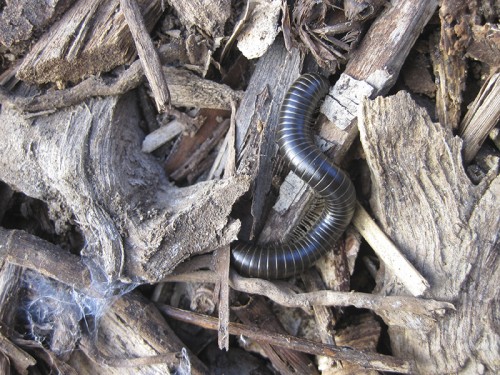 Lifting a rock slab for use in the habitat installation, a millipede is disturbed. Note the wisp of spider cob web lower left — a busy underside of the rock that has rested here only a month.
Lifting a rock slab for use in the habitat installation, a millipede is disturbed. Note the wisp of spider cob web lower left — a busy underside of the rock that has rested here only a month.
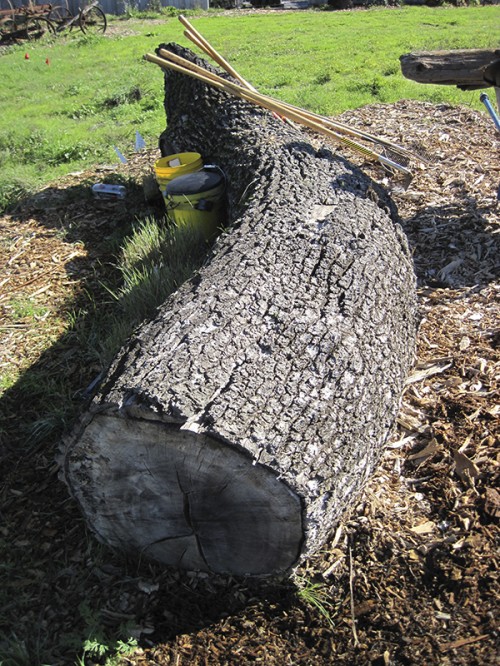 East view of East Heron Hall Log (there are two; the other is West Log), which is next to the habitat installation site. Note the sun-protected trays of meadow barley starts that will be planted. The south face of the log is thick with woodchip mulch to suppress weeds. Lush green grass and weeds in the background — now is the time to plant in Northern California. We can plant native plant starts now and the coming rains will water them, increasing plant survival despite no irrigation used.
East view of East Heron Hall Log (there are two; the other is West Log), which is next to the habitat installation site. Note the sun-protected trays of meadow barley starts that will be planted. The south face of the log is thick with woodchip mulch to suppress weeds. Lush green grass and weeds in the background — now is the time to plant in Northern California. We can plant native plant starts now and the coming rains will water them, increasing plant survival despite no irrigation used.
 Clear the table! Top layer woodchip mulch is scraped away from the work site for 4 reasons: 1) to harvest/collect woodchips that will be under Twisted North Mound (AKA “TNM”), mostly between the 2 large oak tree sections, 2) to access soil from under East Log (foreground), to harvest a thin layer of decayed woodchip-rich topsoil from under the scraped away woodchips, and 4) to keep the woodchips clean and usable as mulch (no soil!) while the habitat site is built.
Clear the table! Top layer woodchip mulch is scraped away from the work site for 4 reasons: 1) to harvest/collect woodchips that will be under Twisted North Mound (AKA “TNM”), mostly between the 2 large oak tree sections, 2) to access soil from under East Log (foreground), to harvest a thin layer of decayed woodchip-rich topsoil from under the scraped away woodchips, and 4) to keep the woodchips clean and usable as mulch (no soil!) while the habitat site is built.
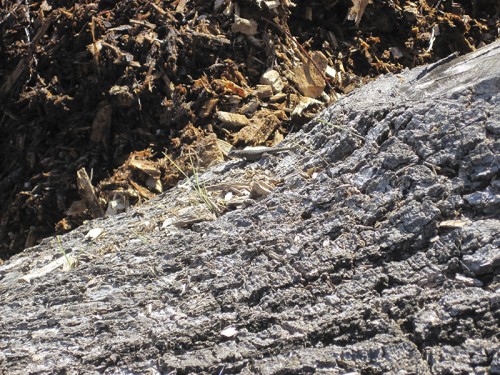 A western fence lizard (Sceloporus occidentalis) is well camouflaged on West Log (center, far edge).
A western fence lizard (Sceloporus occidentalis) is well camouflaged on West Log (center, far edge).
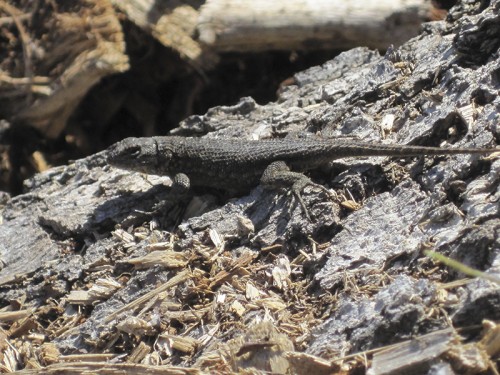 Close-up of wary lizard. Throughout set-up, lizards darted in and out of the Logs’ thick bark layer that has sagged from the harder cambium wood. Perfect habitat for these small creatures.
Close-up of wary lizard. Throughout set-up, lizards darted in and out of the Logs’ thick bark layer that has sagged from the harder cambium wood. Perfect habitat for these small creatures.
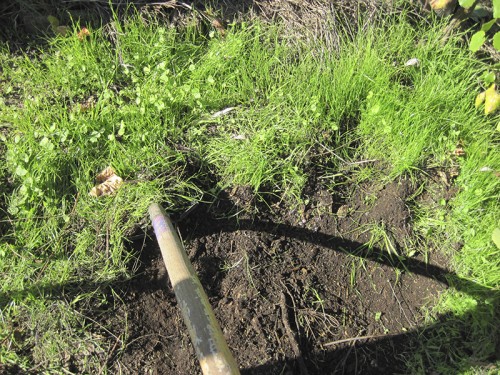 Gathering organic material to create a planted mound, here includes shovel skimming ALIVE topsoil and fresh weeds from a dormant Compost Cricket Corral bin.
Gathering organic material to create a planted mound, here includes shovel skimming ALIVE topsoil and fresh weeds from a dormant Compost Cricket Corral bin.
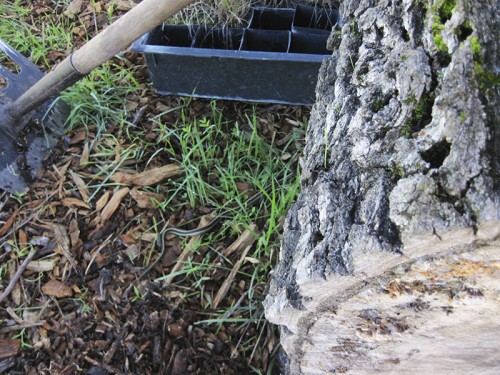 A garter snake escapes from one side of East Log (where I was removing woodchips) to the back side of the log.
A garter snake escapes from one side of East Log (where I was removing woodchips) to the back side of the log.
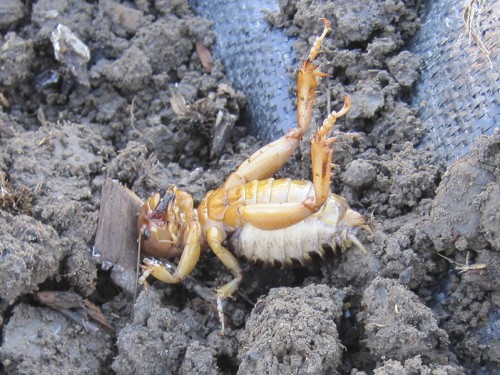 Ouch! Now I know these Jerusalem crickets can bite. Allowing this critter to crawl over onto my hand turned out to be a bad idea; luckily the skin of my finger was not broken by the insect’s jaws. Note that topsoil from under East Log is being harvested for use, and thrown on a tarp, for the West Log habitat mound.
Ouch! Now I know these Jerusalem crickets can bite. Allowing this critter to crawl over onto my hand turned out to be a bad idea; luckily the skin of my finger was not broken by the insect’s jaws. Note that topsoil from under East Log is being harvested for use, and thrown on a tarp, for the West Log habitat mound.
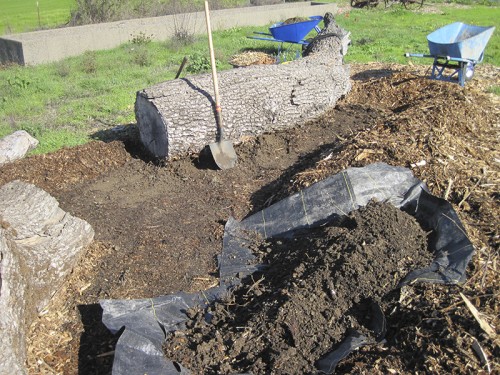 Topsoil on a tarp (foreground) has been harvested from under East Log.
Topsoil on a tarp (foreground) has been harvested from under East Log.
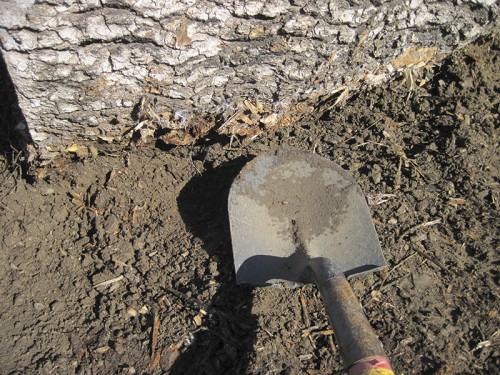 Mushroom layer has been exposed as the oak-tree-to-woodchip-mulch interface is exposed (at tip of shovel).
Mushroom layer has been exposed as the oak-tree-to-woodchip-mulch interface is exposed (at tip of shovel).
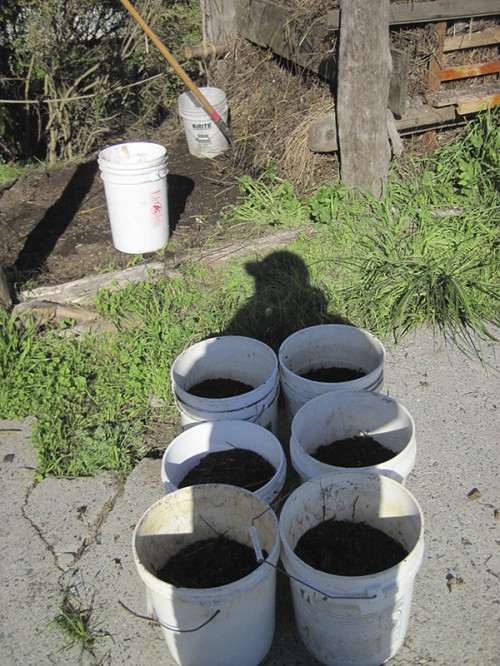 Bucket Man collects fresh compost soil from under compost; note shovel under compost pile in background.
Bucket Man collects fresh compost soil from under compost; note shovel under compost pile in background.
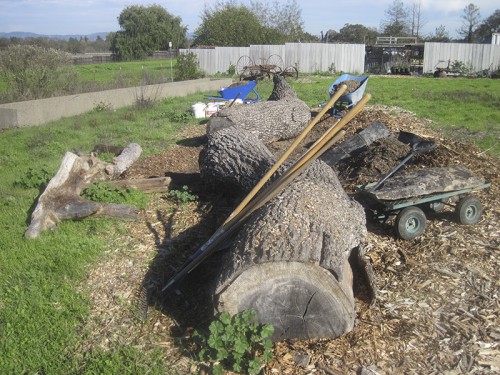 Prep for Twisted North Mound wildlife habitat installation. Starting from west face of West Log, in foreground, moving clockwise: rakes to return woodchip mulch after installation is in, shovels, logs and root pieces (mostly river wood — not salt-cured driftwood), large pond-liner bin of avocado and bamboo leaves, buckets of compost soil, wheelbarrow of old compost and weed surface soil, wheelbarrow of heavy clay soil from under East Log, berm of woodchip mulch, tarp with pile of topsoil from under woodchips, Cold Water Canyon rock slab on rolling cart.
Prep for Twisted North Mound wildlife habitat installation. Starting from west face of West Log, in foreground, moving clockwise: rakes to return woodchip mulch after installation is in, shovels, logs and root pieces (mostly river wood — not salt-cured driftwood), large pond-liner bin of avocado and bamboo leaves, buckets of compost soil, wheelbarrow of old compost and weed surface soil, wheelbarrow of heavy clay soil from under East Log, berm of woodchip mulch, tarp with pile of topsoil from under woodchips, Cold Water Canyon rock slab on rolling cart.
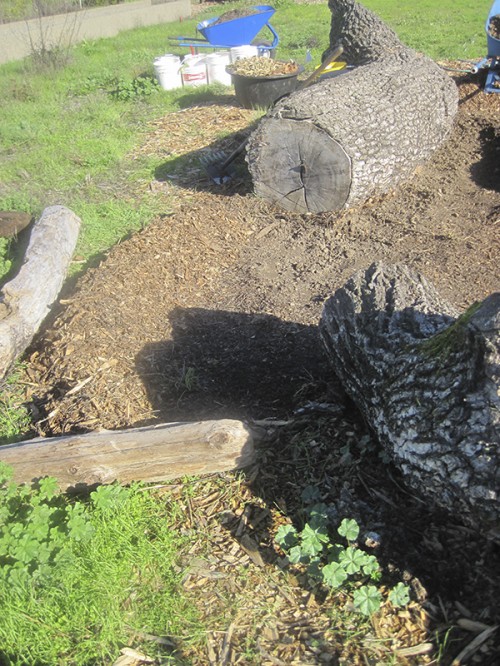 Site scraped and ready for the students to create Twisted North Mound. Note the berm of woodchips on the north side — it will be pushed onto the mound when mulch is called for.
Site scraped and ready for the students to create Twisted North Mound. Note the berm of woodchips on the north side — it will be pushed onto the mound when mulch is called for.
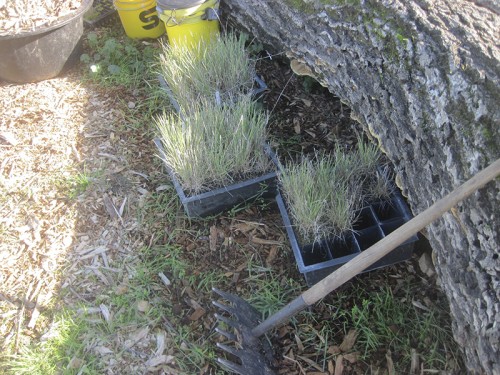 Close-up view of meadow barley plants in waiting. Note the shelf fungus‘ thriving on East Log’s shady side.
Close-up view of meadow barley plants in waiting. Note the shelf fungus‘ thriving on East Log’s shady side.
Students Arrive
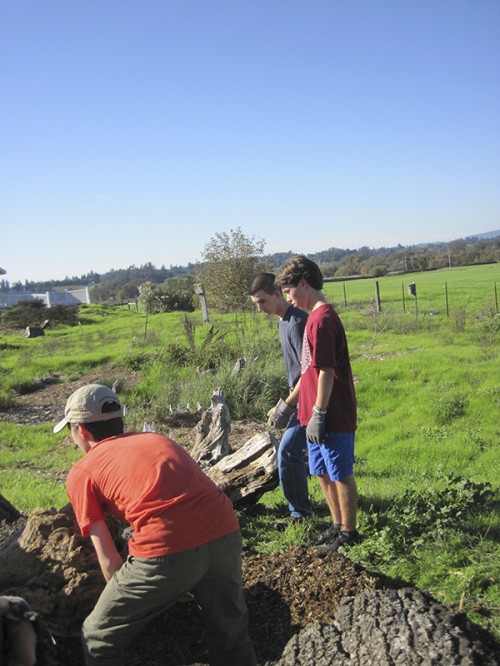 The students have arrived. Their first assignment is to figure which pieces of riverwood/driftwood will create the habitat between East and West Logs. Lots of physics to move the wood around AND not get hurt.
The students have arrived. Their first assignment is to figure which pieces of riverwood/driftwood will create the habitat between East and West Logs. Lots of physics to move the wood around AND not get hurt.
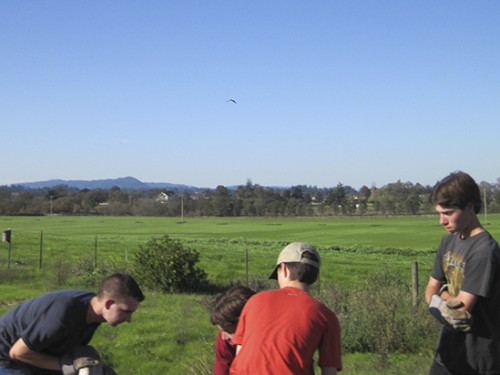 Students deliberate while a great blue heron flies by. Outdoor classrooms rock!
Students deliberate while a great blue heron flies by. Outdoor classrooms rock!
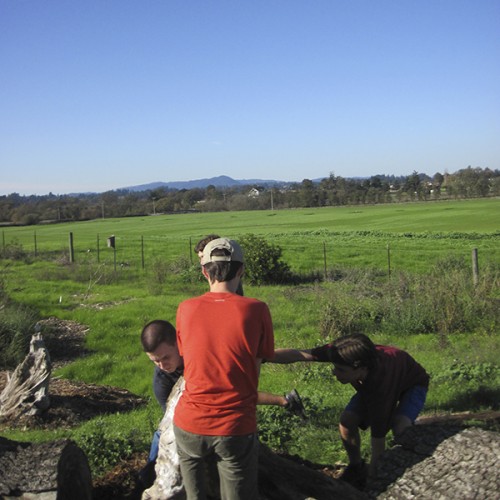 Getting somewhere — this “T-bone” triangular piece of wood will be the habitat’s foundation.
Getting somewhere — this “T-bone” triangular piece of wood will be the habitat’s foundation.
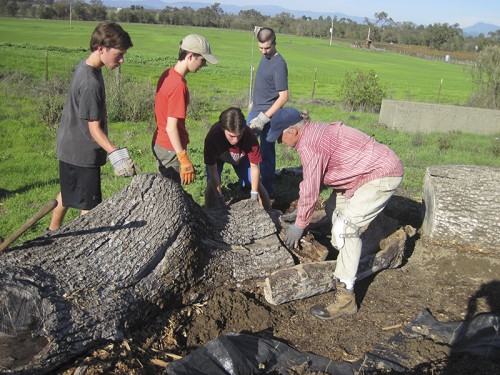 Instructing that we want to snug T-bone up to West Log and to fill it with soil and to be able to plant meadow barley in the crevice. Note that these pieces of wood between East and West Logs will be completely buried, slated to decompose and ultimately leave organic material in the surrounding soil and to leave cavities for critters to someday take advantage of. Are we talking about next year, 2 years from now, or ten years from now? The answer is yes. Habitat It And They Will Come!
Instructing that we want to snug T-bone up to West Log and to fill it with soil and to be able to plant meadow barley in the crevice. Note that these pieces of wood between East and West Logs will be completely buried, slated to decompose and ultimately leave organic material in the surrounding soil and to leave cavities for critters to someday take advantage of. Are we talking about next year, 2 years from now, or ten years from now? The answer is yes. Habitat It And They Will Come!
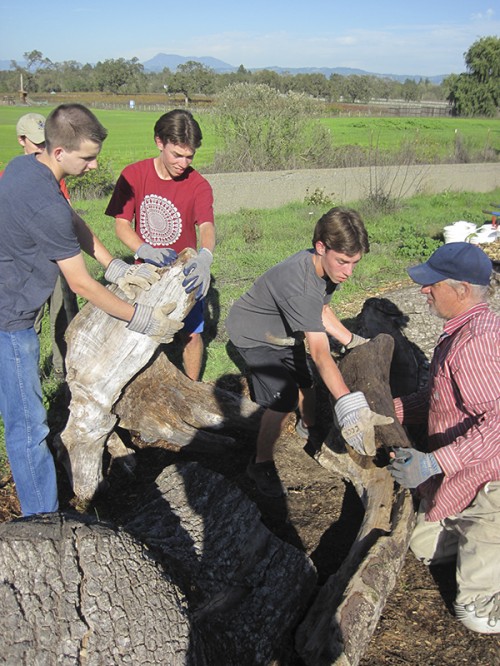 Flipping up T-bone (left) to allow a small piece of old (ready for insects to eat!) wood to snuggle under T-bone.
Flipping up T-bone (left) to allow a small piece of old (ready for insects to eat!) wood to snuggle under T-bone.
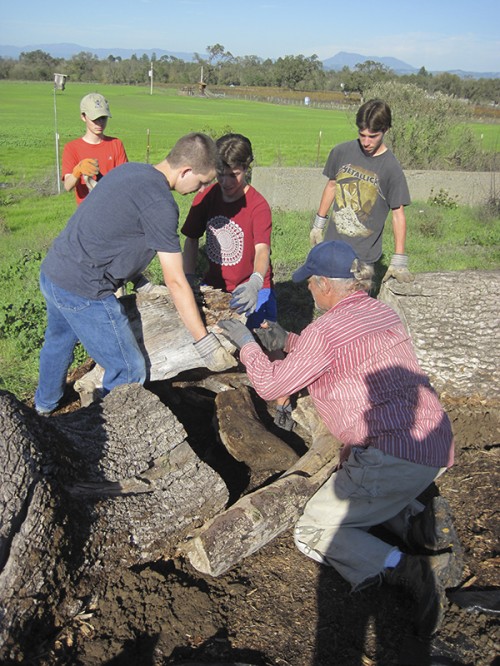 Back down goes T-bone, over other hulks of wood. Different pieces of wood mean different resources for habitat critters — different food, different water saturation, different decay schedules and by-products. Our aim here is to invite DIFFERENT critters.
Back down goes T-bone, over other hulks of wood. Different pieces of wood mean different resources for habitat critters — different food, different water saturation, different decay schedules and by-products. Our aim here is to invite DIFFERENT critters.
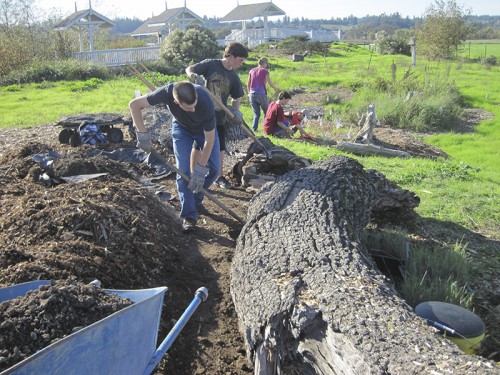 Orchard View students and teacher Sunny Galbraith at work. (Foreground) Digging out clay soil from under East Log. East Log is unashamedly laying with its cut end in full view (a problem). Following the permaculture principle “the problem is the solution”, we use clay soil from under East Log to cover West Log’s exposed corner and Twisted North Mound. Stay tuned for what happens to West Log. (Center) Working the clay soil from under East Log in the crevices of TNM. We want to pack in the soil so the plants will have maximum soil, no air pockets that would kill the meadow barley starts roots. (Background) Weeding Torrent Critter Crag, giving the torrent sedge plugs a better chance to survive, thrive.
Orchard View students and teacher Sunny Galbraith at work. (Foreground) Digging out clay soil from under East Log. East Log is unashamedly laying with its cut end in full view (a problem). Following the permaculture principle “the problem is the solution”, we use clay soil from under East Log to cover West Log’s exposed corner and Twisted North Mound. Stay tuned for what happens to West Log. (Center) Working the clay soil from under East Log in the crevices of TNM. We want to pack in the soil so the plants will have maximum soil, no air pockets that would kill the meadow barley starts roots. (Background) Weeding Torrent Critter Crag, giving the torrent sedge plugs a better chance to survive, thrive.
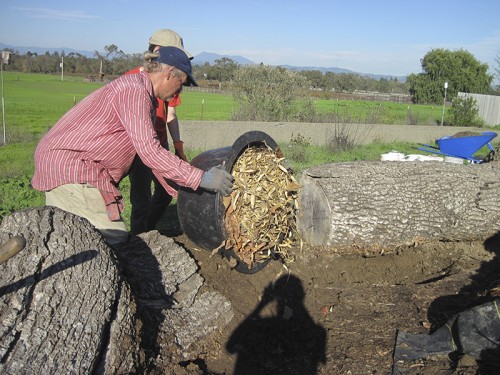 Twisted North Mound gets avocado tree and bamboo leaves over its clay soil base. The organic layer will break down, while it is eaten by soil microbes and crawly critters, and leave a loose, cavity-filled layer under the barley meadow root canopy.
Twisted North Mound gets avocado tree and bamboo leaves over its clay soil base. The organic layer will break down, while it is eaten by soil microbes and crawly critters, and leave a loose, cavity-filled layer under the barley meadow root canopy.
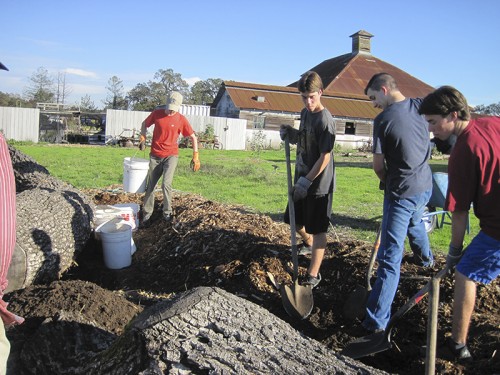 Covering the leaves with the soil scraped under the woodchips that were pushed back from the habitat site. Buckets of compost soil at the ready; that layer will be the top layer that the meadow barley starts are planted in.
Covering the leaves with the soil scraped under the woodchips that were pushed back from the habitat site. Buckets of compost soil at the ready; that layer will be the top layer that the meadow barley starts are planted in.
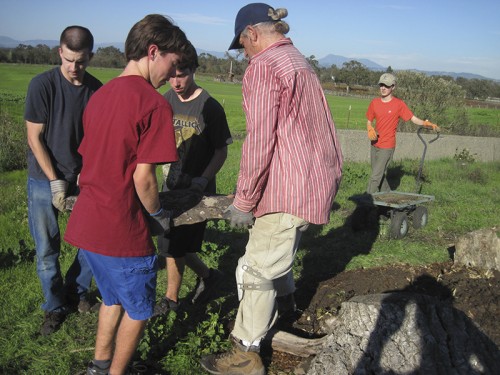 The rock slab is moved into position.
The rock slab is moved into position.
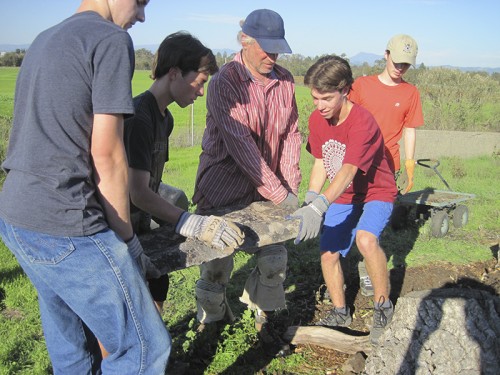 And down, with the tip of the rock resting on a short length of rootwood (hard, long-to-decay wood) and the rest of the rock resting on the pile of small rocks that we collected while digging under East Log. The rocks found while digging, a problem, became a solution when wanting to create a space under the rock slab.
And down, with the tip of the rock resting on a short length of rootwood (hard, long-to-decay wood) and the rest of the rock resting on the pile of small rocks that we collected while digging under East Log. The rocks found while digging, a problem, became a solution when wanting to create a space under the rock slab.
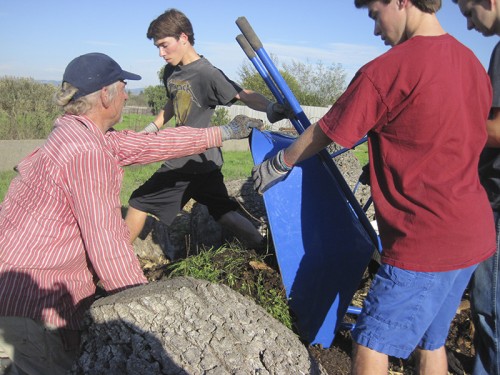 Another organic layer — the old compost and fresh grasses/weeds, complete with thriving soil microbes and crawly critters, will make a rich layer under the compost soil. The goal is to have the compost soil and woodchip mulch kill down any of the grasses/weeds.
Another organic layer — the old compost and fresh grasses/weeds, complete with thriving soil microbes and crawly critters, will make a rich layer under the compost soil. The goal is to have the compost soil and woodchip mulch kill down any of the grasses/weeds.
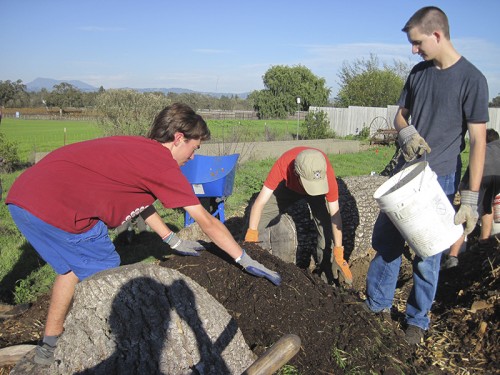 Compost soil is sculpted to create a planting mound.
Compost soil is sculpted to create a planting mound.
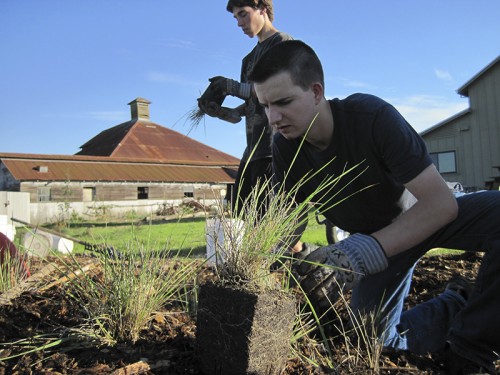 Meadow barley starts are planted. Note the rectangular root form to the plant in the foreground — these start plants were touseled, squeezed, massaged, and even roots ripped free to allow the plant a non-rectangular root spread. Free the roots!
Meadow barley starts are planted. Note the rectangular root form to the plant in the foreground — these start plants were touseled, squeezed, massaged, and even roots ripped free to allow the plant a non-rectangular root spread. Free the roots!
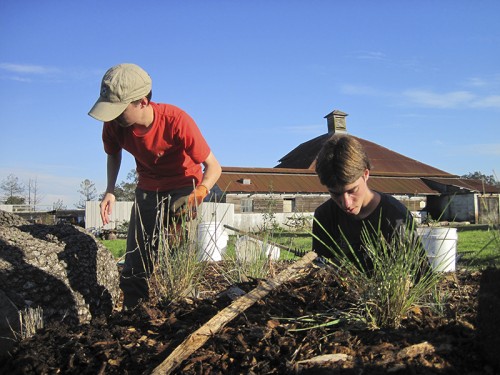 Meadow barley starts planted among woodchip mulch.
Meadow barley starts planted among woodchip mulch.
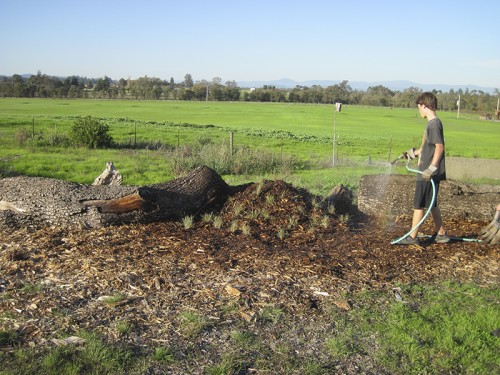 And a little water for the meadow barley,
And a little water for the meadow barley,
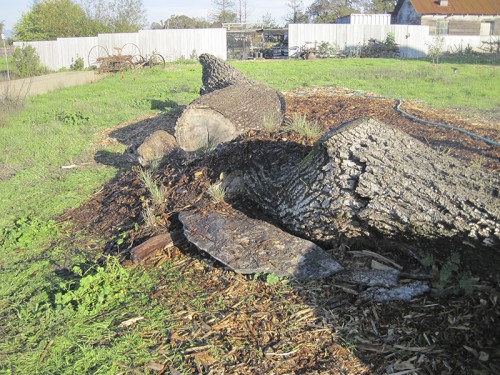 Twisted North Mound wildlife habitat installation is in! East view of back side.
Twisted North Mound wildlife habitat installation is in! East view of back side.
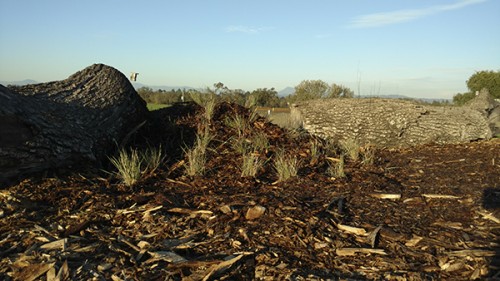 North view of habitat’s “front”, that is, the view from behind Heron Hall.
North view of habitat’s “front”, that is, the view from behind Heron Hall.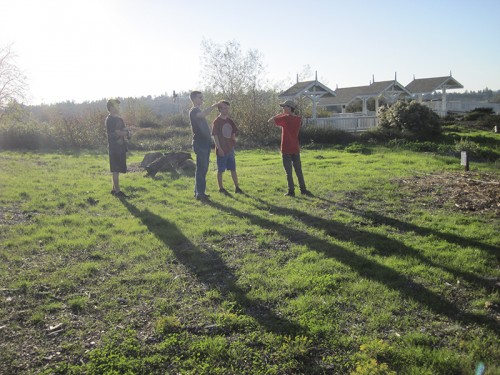 Students deliberate, time to talk amongst themselves after a successful work session.
Students deliberate, time to talk amongst themselves after a successful work session.
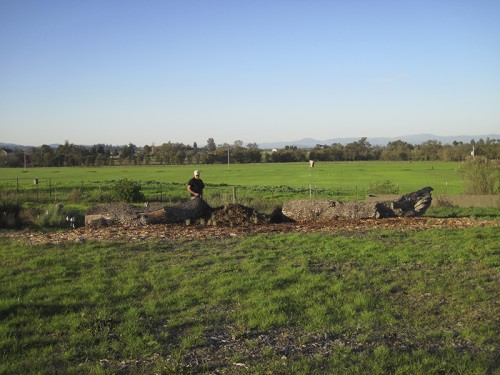 Brent Reed, of the Laguna Foundation, inspects Twisted North Mound on installation day. Good thing this habitat was built to meet or surpass the latest Habitat Building Code.
Brent Reed, of the Laguna Foundation, inspects Twisted North Mound on installation day. Good thing this habitat was built to meet or surpass the latest Habitat Building Code.
Thank you, as always, to Sunny Galbraith, teacher at Orchard View School, Sebastopol, and her students. Also, much thanks to the staff and board of the Laguna Foundation, particularly the Restoration and Conservation Science Department: Wendy Trowbridge, Director; Brent Reed, Ecological Program Manager; Aaron Nunez, Ecological Project Manager; and Paul Weber, Restoration Field Supervisor.
Enjoy your wildlife habitat installations. Habitat it!
Tony

